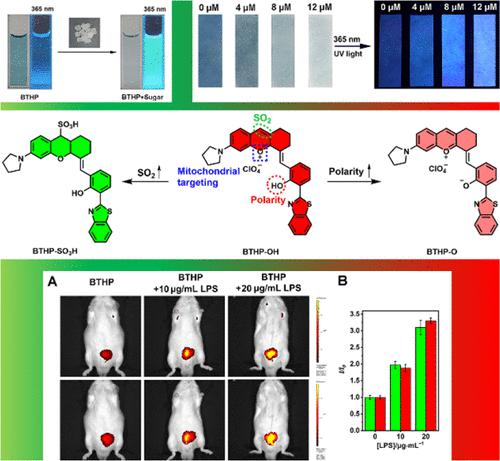当前位置:
X-MOL 学术
›
Anal. Chem.
›
论文详情
Our official English website, www.x-mol.net, welcomes your
feedback! (Note: you will need to create a separate account there.)
NIR Mitochondrial Fluorescent Probe for Visualizing SO2/Polarity in Drug Induced Inflammatory Mice
Analytical Chemistry ( IF 6.7 ) Pub Date : 2023-03-13 , DOI: 10.1021/acs.analchem.2c05737 Shen Zhang 1 , Hongyong Zheng 2 , Lei Yang 2 , Zhanxian Li 1 , Mingming Yu 1
Analytical Chemistry ( IF 6.7 ) Pub Date : 2023-03-13 , DOI: 10.1021/acs.analchem.2c05737 Shen Zhang 1 , Hongyong Zheng 2 , Lei Yang 2 , Zhanxian Li 1 , Mingming Yu 1
Affiliation

|
SO2 and polarity are important microenvironmental parameters in cells, which are closely related to physiological activities in organisms. The intracellular levels of SO2 and polarity are abnormal in inflammatory models. To this end, a novel near-infrared fluorescent probe BTHP that can simultaneously detect SO2 and polarity was studied. BTHP can sensitively detect polarity change with emission peak change from 677 to 818 nm. BTHP can also detect SO2 with fluorescence change from red to green. After addition of SO2, the fluorescence emission intensity ratio I517/I768 of the probe increased by about 33.6 times. BTHP can determine bisulfite in single crystal rock sugar with high recovery rate (99.2%–101.7%). Fluorescence imaging of cells showed that BTHP could better target mitochondria and monitor exogenous SO2 in A549 cells. More importantly, BTHP has been successfully used for dual channel monitoring SO2 and polarity in drug-induced inflammatory cells and mice. In particular, the probe showed increased green fluorescence with the generation of SO2 and increased red fluorescence with the decrease of polarity in inflammatory cells and mice.
中文翻译:

近红外线粒体荧光探针,用于在药物诱导的炎症小鼠中可视化 SO2/极性
SO 2和极性是细胞内重要的微环境参数,与生物体的生理活动密切相关。炎症模型中 SO 2的细胞内水平和极性异常。为此,研究了一种可同时检测SO 2和极性的新型近红外荧光探针BTHP。BTHP 可以灵敏地检测极性变化,发射峰从 677 nm 变化到 818 nm。BTHP还可以检测荧光由红变绿的SO 2 。添加SO 2后,荧光发射强度比I 517 / I 768的探头增加了约 33.6 倍。BTHP测定单晶冰糖中的亚硫酸氢盐,回收率高(99.2%~101.7%)。细胞的荧光成像表明,BTHP 可以更好地靶向线粒体并监测A549 细胞中的外源性 SO 2 。更重要的是,BTHP 已成功用于双通道监测药物诱导的炎症细胞和小鼠的SO 2和极性。特别是,该探针在炎性细胞和小鼠中显示出随着 SO 2的产生而增加的绿色荧光和随着极性的降低而增加的红色荧光。
更新日期:2023-03-13
中文翻译:

近红外线粒体荧光探针,用于在药物诱导的炎症小鼠中可视化 SO2/极性
SO 2和极性是细胞内重要的微环境参数,与生物体的生理活动密切相关。炎症模型中 SO 2的细胞内水平和极性异常。为此,研究了一种可同时检测SO 2和极性的新型近红外荧光探针BTHP。BTHP 可以灵敏地检测极性变化,发射峰从 677 nm 变化到 818 nm。BTHP还可以检测荧光由红变绿的SO 2 。添加SO 2后,荧光发射强度比I 517 / I 768的探头增加了约 33.6 倍。BTHP测定单晶冰糖中的亚硫酸氢盐,回收率高(99.2%~101.7%)。细胞的荧光成像表明,BTHP 可以更好地靶向线粒体并监测A549 细胞中的外源性 SO 2 。更重要的是,BTHP 已成功用于双通道监测药物诱导的炎症细胞和小鼠的SO 2和极性。特别是,该探针在炎性细胞和小鼠中显示出随着 SO 2的产生而增加的绿色荧光和随着极性的降低而增加的红色荧光。





















































 京公网安备 11010802027423号
京公网安备 11010802027423号